Machine Learning Overview: ITS 531 Module 3 Essay - University Name
VerifiedAdded on 2022/10/18
|5
|1122
|13
Essay
AI Summary
This essay provides an overview of machine learning, differentiating between supervised and unsupervised learning methods. It explains how artificial neural networks utilize supervised learning for predictive decision-making. The essay further presents real-world examples of each type of learning in data science, such as fraud detection (supervised) and other applications. The paper is based on the ITS 531 Module 3 assignment, and it also includes citations and references to support the findings. The essay offers insights into the practical use of machine learning algorithms and their significance in data analysis.
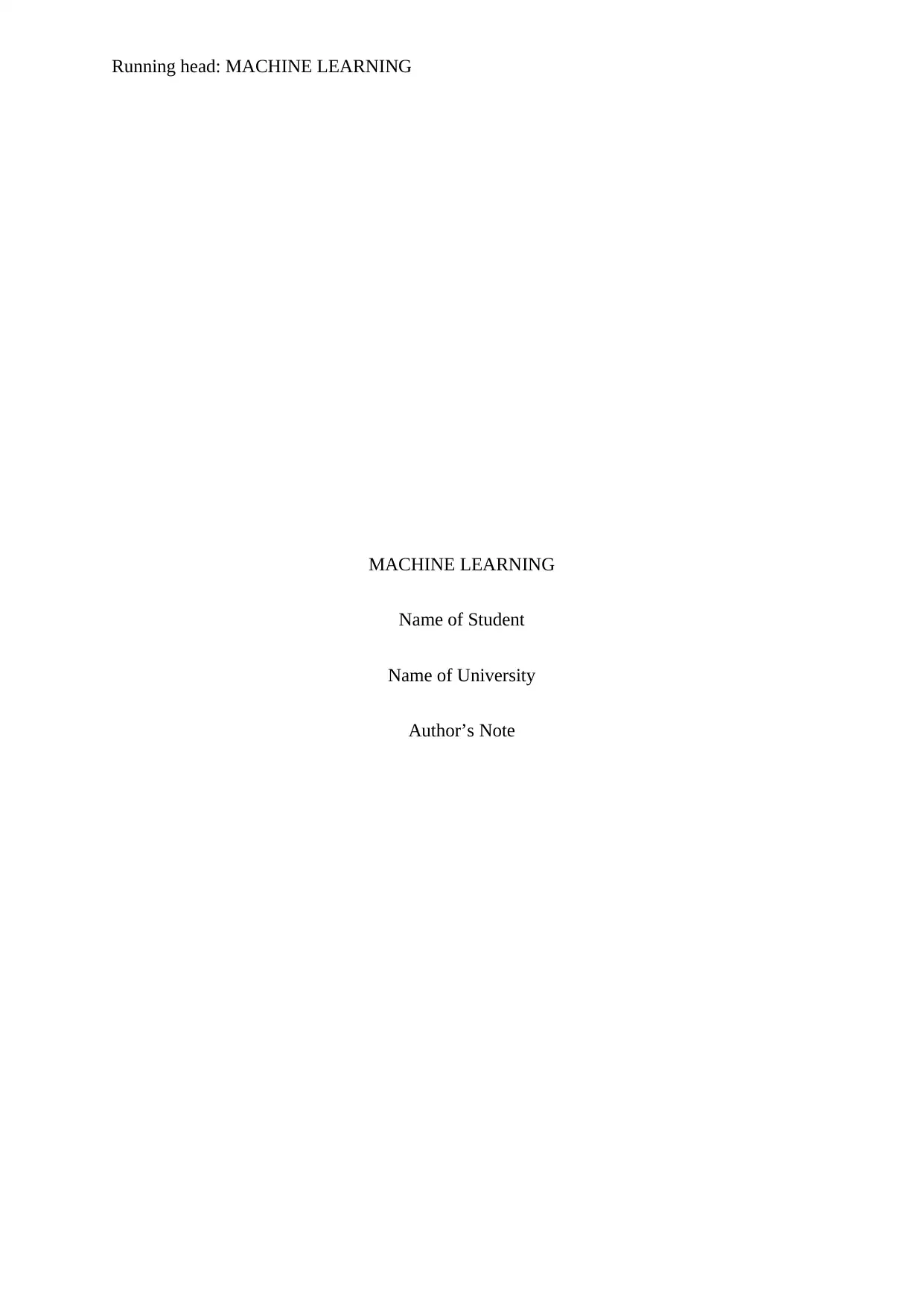
Running head: MACHINE LEARNING
MACHINE LEARNING
Name of Student
Name of University
Author’s Note
MACHINE LEARNING
Name of Student
Name of University
Author’s Note
Paraphrase This Document
Need a fresh take? Get an instant paraphrase of this document with our AI Paraphraser
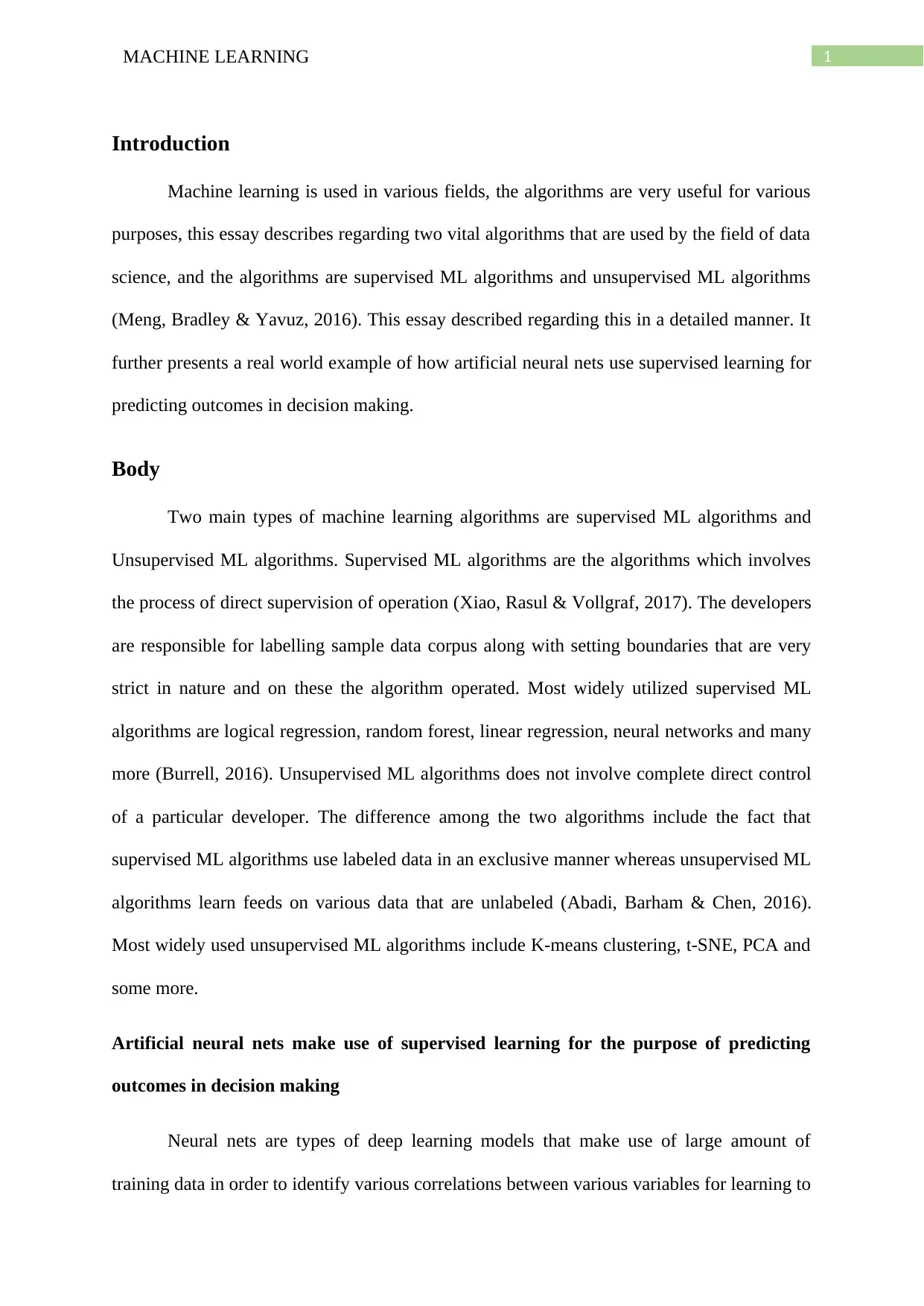
1MACHINE LEARNING
Introduction
Machine learning is used in various fields, the algorithms are very useful for various
purposes, this essay describes regarding two vital algorithms that are used by the field of data
science, and the algorithms are supervised ML algorithms and unsupervised ML algorithms
(Meng, Bradley & Yavuz, 2016). This essay described regarding this in a detailed manner. It
further presents a real world example of how artificial neural nets use supervised learning for
predicting outcomes in decision making.
Body
Two main types of machine learning algorithms are supervised ML algorithms and
Unsupervised ML algorithms. Supervised ML algorithms are the algorithms which involves
the process of direct supervision of operation (Xiao, Rasul & Vollgraf, 2017). The developers
are responsible for labelling sample data corpus along with setting boundaries that are very
strict in nature and on these the algorithm operated. Most widely utilized supervised ML
algorithms are logical regression, random forest, linear regression, neural networks and many
more (Burrell, 2016). Unsupervised ML algorithms does not involve complete direct control
of a particular developer. The difference among the two algorithms include the fact that
supervised ML algorithms use labeled data in an exclusive manner whereas unsupervised ML
algorithms learn feeds on various data that are unlabeled (Abadi, Barham & Chen, 2016).
Most widely used unsupervised ML algorithms include K-means clustering, t-SNE, PCA and
some more.
Artificial neural nets make use of supervised learning for the purpose of predicting
outcomes in decision making
Neural nets are types of deep learning models that make use of large amount of
training data in order to identify various correlations between various variables for learning to
Introduction
Machine learning is used in various fields, the algorithms are very useful for various
purposes, this essay describes regarding two vital algorithms that are used by the field of data
science, and the algorithms are supervised ML algorithms and unsupervised ML algorithms
(Meng, Bradley & Yavuz, 2016). This essay described regarding this in a detailed manner. It
further presents a real world example of how artificial neural nets use supervised learning for
predicting outcomes in decision making.
Body
Two main types of machine learning algorithms are supervised ML algorithms and
Unsupervised ML algorithms. Supervised ML algorithms are the algorithms which involves
the process of direct supervision of operation (Xiao, Rasul & Vollgraf, 2017). The developers
are responsible for labelling sample data corpus along with setting boundaries that are very
strict in nature and on these the algorithm operated. Most widely utilized supervised ML
algorithms are logical regression, random forest, linear regression, neural networks and many
more (Burrell, 2016). Unsupervised ML algorithms does not involve complete direct control
of a particular developer. The difference among the two algorithms include the fact that
supervised ML algorithms use labeled data in an exclusive manner whereas unsupervised ML
algorithms learn feeds on various data that are unlabeled (Abadi, Barham & Chen, 2016).
Most widely used unsupervised ML algorithms include K-means clustering, t-SNE, PCA and
some more.
Artificial neural nets make use of supervised learning for the purpose of predicting
outcomes in decision making
Neural nets are types of deep learning models that make use of large amount of
training data in order to identify various correlations between various variables for learning to
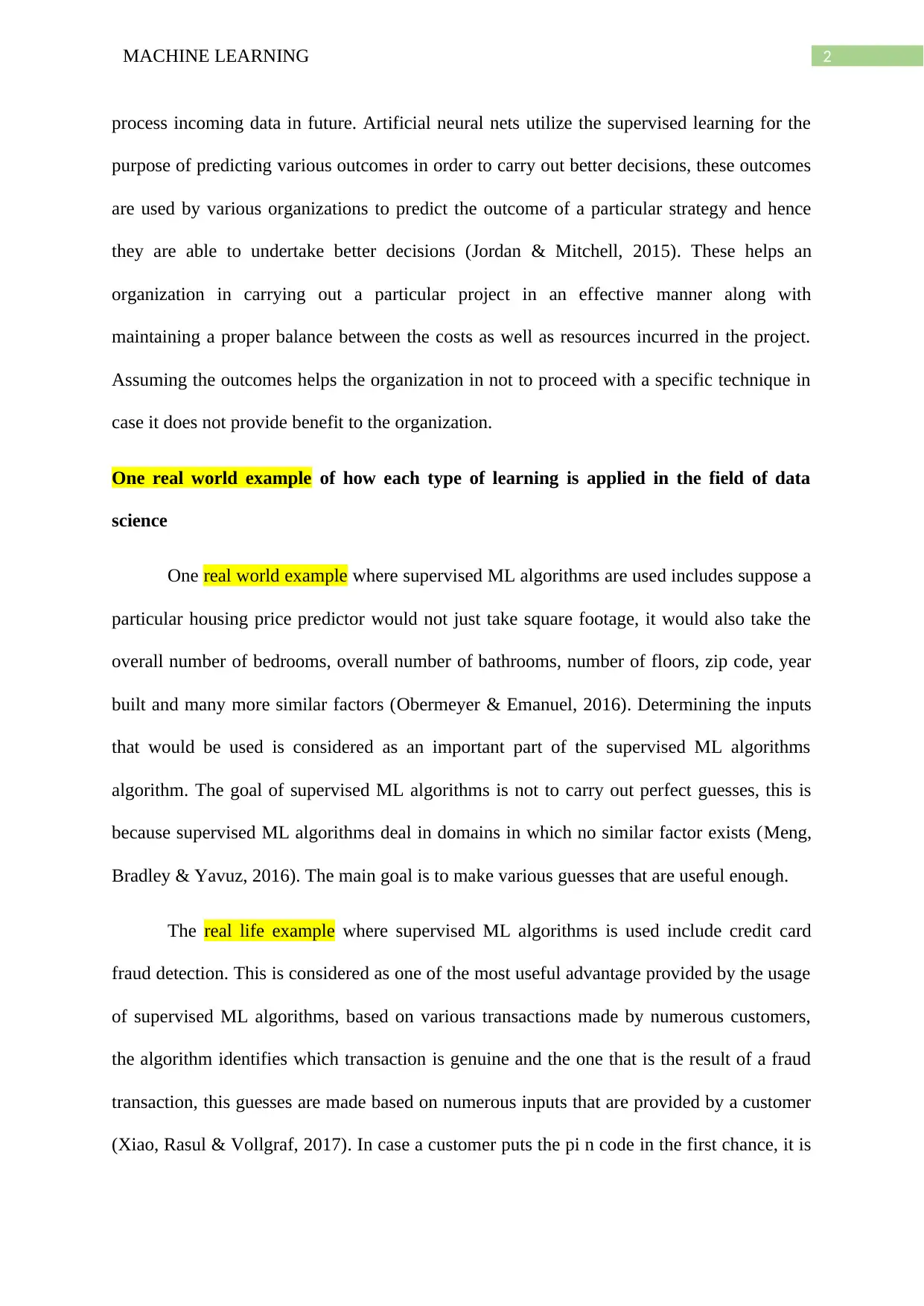
2MACHINE LEARNING
process incoming data in future. Artificial neural nets utilize the supervised learning for the
purpose of predicting various outcomes in order to carry out better decisions, these outcomes
are used by various organizations to predict the outcome of a particular strategy and hence
they are able to undertake better decisions (Jordan & Mitchell, 2015). These helps an
organization in carrying out a particular project in an effective manner along with
maintaining a proper balance between the costs as well as resources incurred in the project.
Assuming the outcomes helps the organization in not to proceed with a specific technique in
case it does not provide benefit to the organization.
One real world example of how each type of learning is applied in the field of data
science
One real world example where supervised ML algorithms are used includes suppose a
particular housing price predictor would not just take square footage, it would also take the
overall number of bedrooms, overall number of bathrooms, number of floors, zip code, year
built and many more similar factors (Obermeyer & Emanuel, 2016). Determining the inputs
that would be used is considered as an important part of the supervised ML algorithms
algorithm. The goal of supervised ML algorithms is not to carry out perfect guesses, this is
because supervised ML algorithms deal in domains in which no similar factor exists (Meng,
Bradley & Yavuz, 2016). The main goal is to make various guesses that are useful enough.
The real life example where supervised ML algorithms is used include credit card
fraud detection. This is considered as one of the most useful advantage provided by the usage
of supervised ML algorithms, based on various transactions made by numerous customers,
the algorithm identifies which transaction is genuine and the one that is the result of a fraud
transaction, this guesses are made based on numerous inputs that are provided by a customer
(Xiao, Rasul & Vollgraf, 2017). In case a customer puts the pi n code in the first chance, it is
process incoming data in future. Artificial neural nets utilize the supervised learning for the
purpose of predicting various outcomes in order to carry out better decisions, these outcomes
are used by various organizations to predict the outcome of a particular strategy and hence
they are able to undertake better decisions (Jordan & Mitchell, 2015). These helps an
organization in carrying out a particular project in an effective manner along with
maintaining a proper balance between the costs as well as resources incurred in the project.
Assuming the outcomes helps the organization in not to proceed with a specific technique in
case it does not provide benefit to the organization.
One real world example of how each type of learning is applied in the field of data
science
One real world example where supervised ML algorithms are used includes suppose a
particular housing price predictor would not just take square footage, it would also take the
overall number of bedrooms, overall number of bathrooms, number of floors, zip code, year
built and many more similar factors (Obermeyer & Emanuel, 2016). Determining the inputs
that would be used is considered as an important part of the supervised ML algorithms
algorithm. The goal of supervised ML algorithms is not to carry out perfect guesses, this is
because supervised ML algorithms deal in domains in which no similar factor exists (Meng,
Bradley & Yavuz, 2016). The main goal is to make various guesses that are useful enough.
The real life example where supervised ML algorithms is used include credit card
fraud detection. This is considered as one of the most useful advantage provided by the usage
of supervised ML algorithms, based on various transactions made by numerous customers,
the algorithm identifies which transaction is genuine and the one that is the result of a fraud
transaction, this guesses are made based on numerous inputs that are provided by a customer
(Xiao, Rasul & Vollgraf, 2017). In case a customer puts the pi n code in the first chance, it is
⊘ This is a preview!⊘
Do you want full access?
Subscribe today to unlock all pages.

Trusted by 1+ million students worldwide
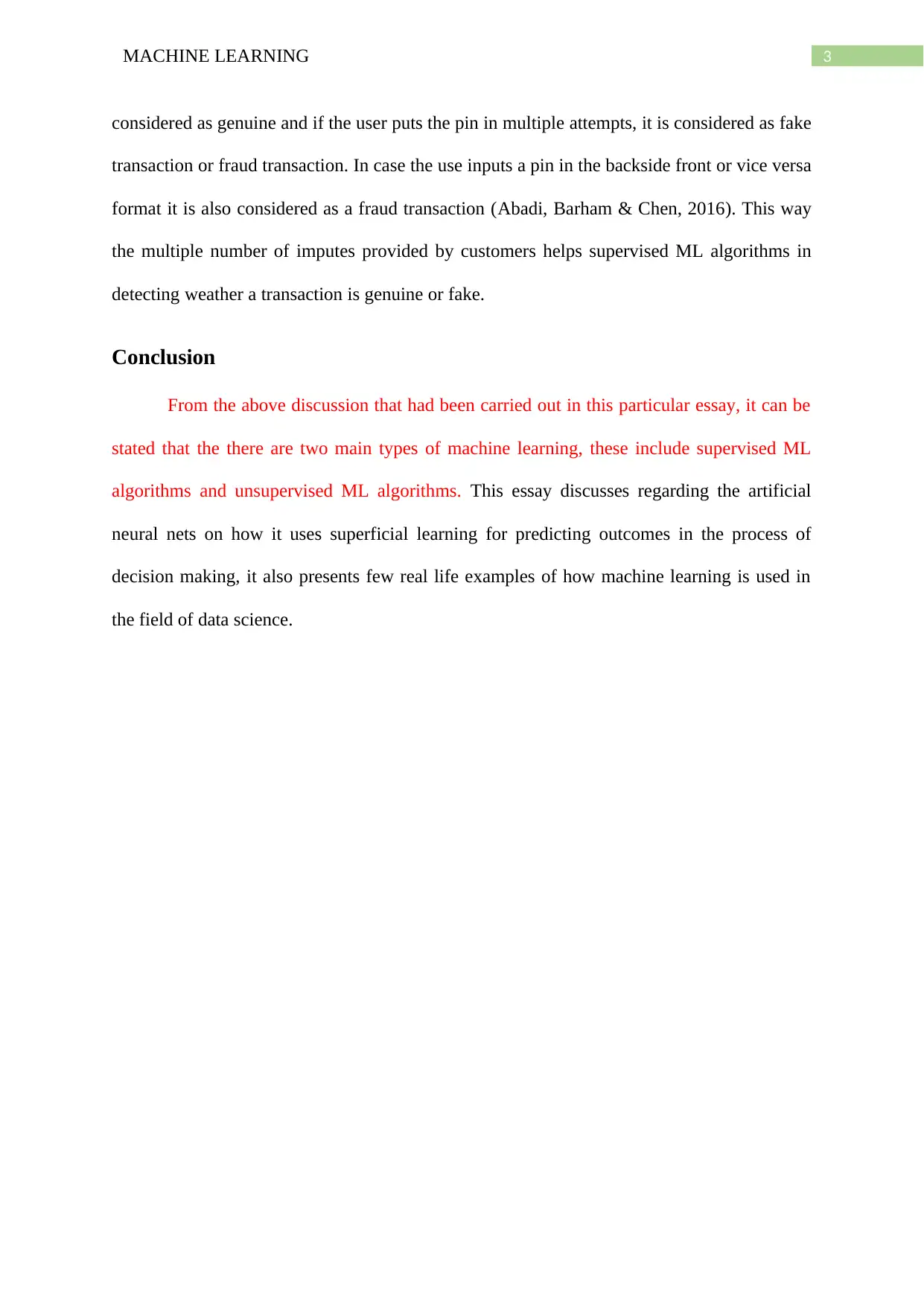
3MACHINE LEARNING
considered as genuine and if the user puts the pin in multiple attempts, it is considered as fake
transaction or fraud transaction. In case the use inputs a pin in the backside front or vice versa
format it is also considered as a fraud transaction (Abadi, Barham & Chen, 2016). This way
the multiple number of imputes provided by customers helps supervised ML algorithms in
detecting weather a transaction is genuine or fake.
Conclusion
From the above discussion that had been carried out in this particular essay, it can be
stated that the there are two main types of machine learning, these include supervised ML
algorithms and unsupervised ML algorithms. This essay discusses regarding the artificial
neural nets on how it uses superficial learning for predicting outcomes in the process of
decision making, it also presents few real life examples of how machine learning is used in
the field of data science.
considered as genuine and if the user puts the pin in multiple attempts, it is considered as fake
transaction or fraud transaction. In case the use inputs a pin in the backside front or vice versa
format it is also considered as a fraud transaction (Abadi, Barham & Chen, 2016). This way
the multiple number of imputes provided by customers helps supervised ML algorithms in
detecting weather a transaction is genuine or fake.
Conclusion
From the above discussion that had been carried out in this particular essay, it can be
stated that the there are two main types of machine learning, these include supervised ML
algorithms and unsupervised ML algorithms. This essay discusses regarding the artificial
neural nets on how it uses superficial learning for predicting outcomes in the process of
decision making, it also presents few real life examples of how machine learning is used in
the field of data science.
Paraphrase This Document
Need a fresh take? Get an instant paraphrase of this document with our AI Paraphraser
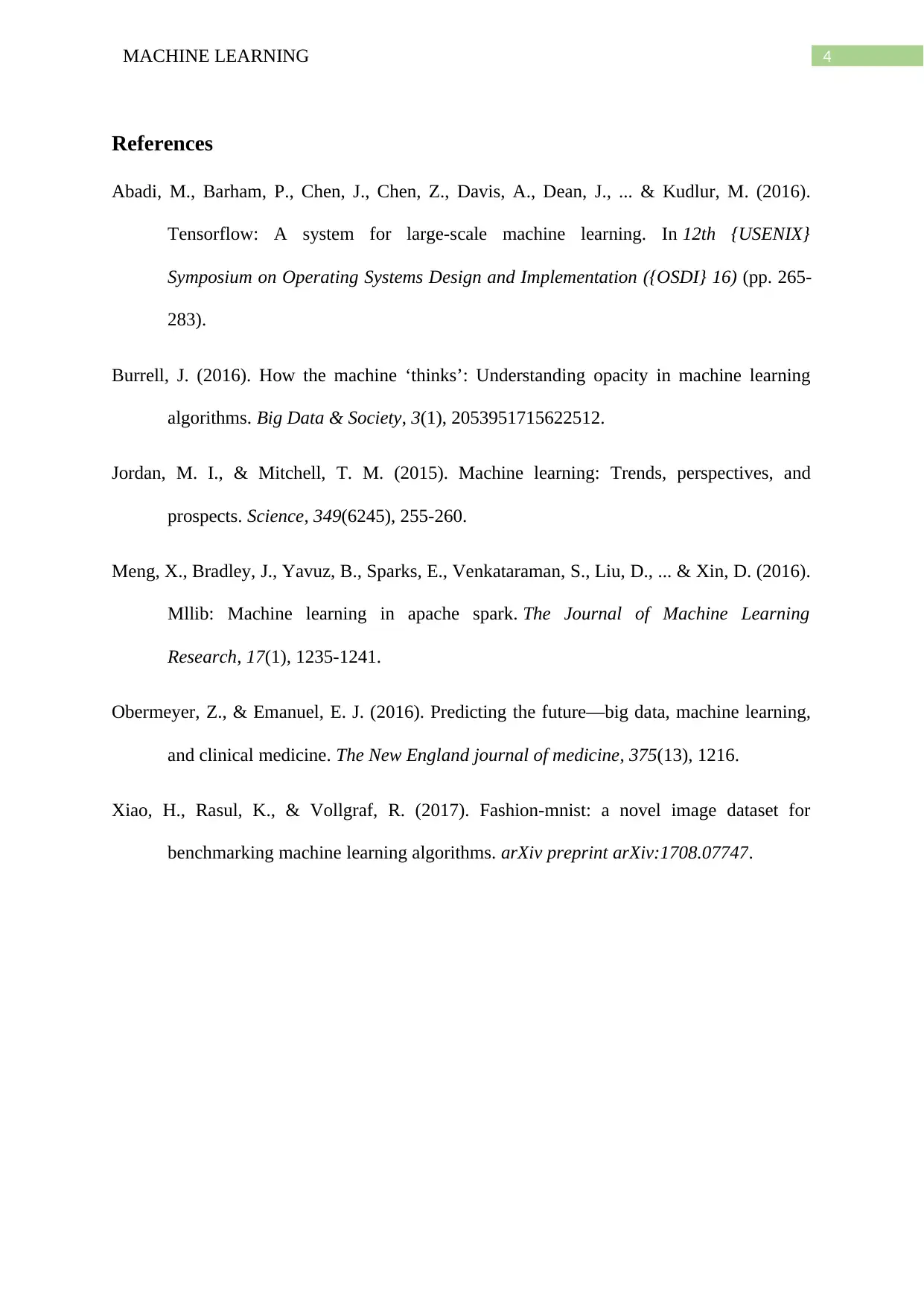
4MACHINE LEARNING
References
Abadi, M., Barham, P., Chen, J., Chen, Z., Davis, A., Dean, J., ... & Kudlur, M. (2016).
Tensorflow: A system for large-scale machine learning. In 12th {USENIX}
Symposium on Operating Systems Design and Implementation ({OSDI} 16) (pp. 265-
283).
Burrell, J. (2016). How the machine ‘thinks’: Understanding opacity in machine learning
algorithms. Big Data & Society, 3(1), 2053951715622512.
Jordan, M. I., & Mitchell, T. M. (2015). Machine learning: Trends, perspectives, and
prospects. Science, 349(6245), 255-260.
Meng, X., Bradley, J., Yavuz, B., Sparks, E., Venkataraman, S., Liu, D., ... & Xin, D. (2016).
Mllib: Machine learning in apache spark. The Journal of Machine Learning
Research, 17(1), 1235-1241.
Obermeyer, Z., & Emanuel, E. J. (2016). Predicting the future—big data, machine learning,
and clinical medicine. The New England journal of medicine, 375(13), 1216.
Xiao, H., Rasul, K., & Vollgraf, R. (2017). Fashion-mnist: a novel image dataset for
benchmarking machine learning algorithms. arXiv preprint arXiv:1708.07747.
References
Abadi, M., Barham, P., Chen, J., Chen, Z., Davis, A., Dean, J., ... & Kudlur, M. (2016).
Tensorflow: A system for large-scale machine learning. In 12th {USENIX}
Symposium on Operating Systems Design and Implementation ({OSDI} 16) (pp. 265-
283).
Burrell, J. (2016). How the machine ‘thinks’: Understanding opacity in machine learning
algorithms. Big Data & Society, 3(1), 2053951715622512.
Jordan, M. I., & Mitchell, T. M. (2015). Machine learning: Trends, perspectives, and
prospects. Science, 349(6245), 255-260.
Meng, X., Bradley, J., Yavuz, B., Sparks, E., Venkataraman, S., Liu, D., ... & Xin, D. (2016).
Mllib: Machine learning in apache spark. The Journal of Machine Learning
Research, 17(1), 1235-1241.
Obermeyer, Z., & Emanuel, E. J. (2016). Predicting the future—big data, machine learning,
and clinical medicine. The New England journal of medicine, 375(13), 1216.
Xiao, H., Rasul, K., & Vollgraf, R. (2017). Fashion-mnist: a novel image dataset for
benchmarking machine learning algorithms. arXiv preprint arXiv:1708.07747.
1 out of 5
Related Documents
Your All-in-One AI-Powered Toolkit for Academic Success.
+13062052269
info@desklib.com
Available 24*7 on WhatsApp / Email
![[object Object]](/_next/static/media/star-bottom.7253800d.svg)
Unlock your academic potential
Copyright © 2020–2025 A2Z Services. All Rights Reserved. Developed and managed by ZUCOL.





